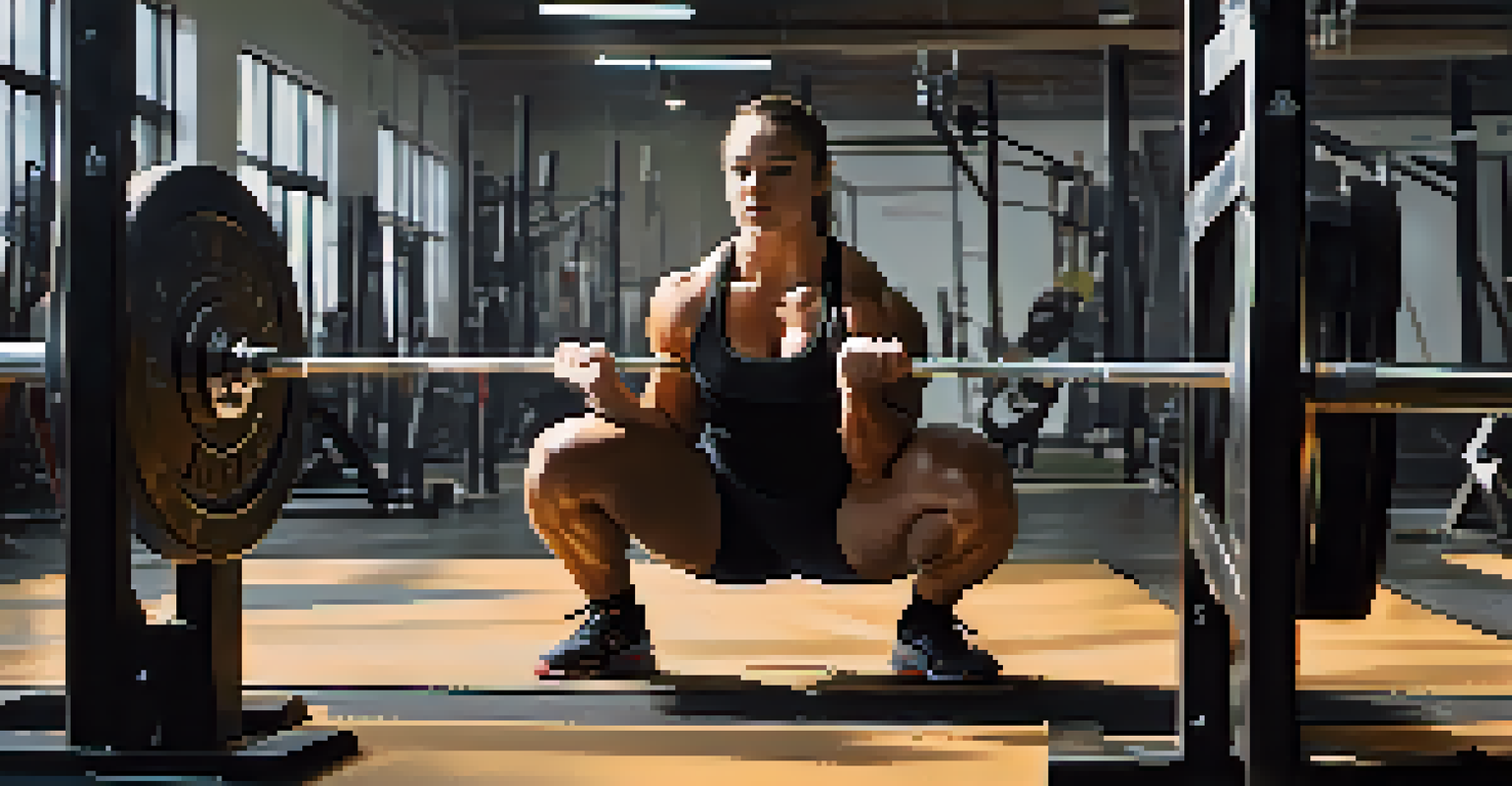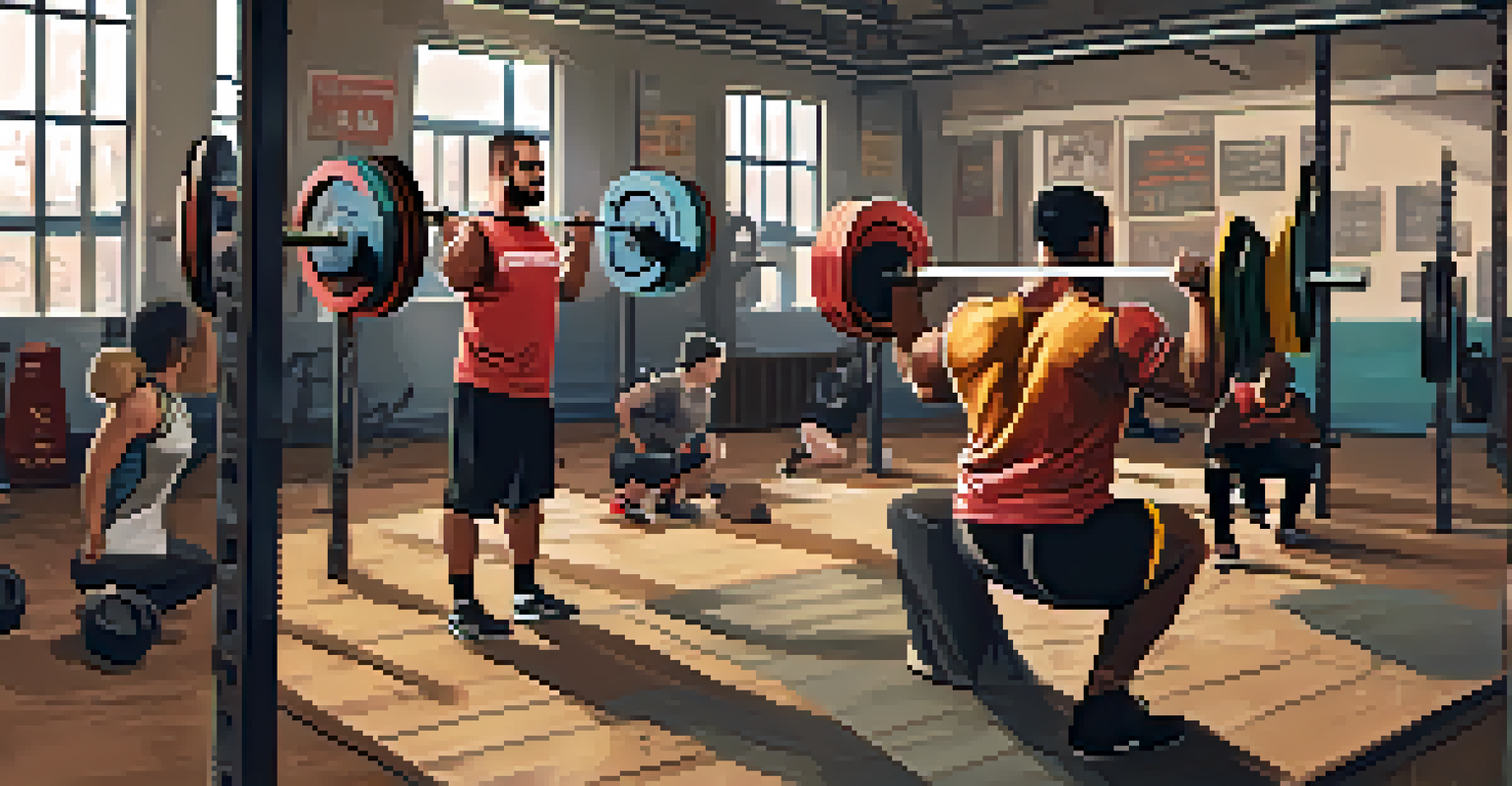Understanding the Back Squat: Benefits for Powerlifting Success

What is the Back Squat and Why is it Important?
The back squat is a fundamental exercise in powerlifting that targets multiple muscle groups, primarily the quads, hamstrings, and glutes. Unlike other squats, this variation involves placing the barbell across your upper back, which allows for greater loading potential. By mastering the back squat, lifters can build a solid foundation for their overall strength and powerlifting success.
Strength does not come from physical capacity. It comes from an indomitable will.
One of the key reasons the back squat is essential is its role in developing overall leg strength. Strong legs not only improve your squat but also enhance your deadlift and bench press. This interconnectedness is what makes the back squat a staple in any powerlifter’s training regimen.
Moreover, the back squat is a compound movement, meaning it engages multiple joints and muscles simultaneously. This makes it incredibly effective for building functional strength, which is crucial for lifting heavier weights in competitions.
Muscle Activation and Growth Through the Back Squat
The back squat is particularly effective in activating the muscles of the lower body. As you descend into the squat, your quads, hamstrings, and glutes work in unison to control the movement. This high level of muscle activation is vital for stimulating muscle growth and improving overall strength.

Additionally, the squat encourages the recruitment of stabilizer muscles, including the core and lower back, which are essential for maintaining proper form. A strong core not only supports heavier lifts but also reduces the risk of injury. Therefore, incorporating back squats into your routine can lead to comprehensive strength gains.
Back Squats Build Overall Strength
The back squat is essential for developing leg strength, which enhances performance in other lifts like the deadlift and bench press.
It's also worth noting that the back squat promotes hypertrophy, or muscle growth, through time under tension. The longer your muscles are engaged during the lift, the more they adapt and grow. This principle is crucial for powerlifters looking to increase their muscle mass and, consequently, their lifting capacity.
Improving Mobility and Flexibility with Back Squats
One often overlooked benefit of the back squat is its role in enhancing mobility and flexibility. As you perform squats regularly, your hips, knees, and ankles become more mobile, which can improve your overall movement patterns. This increased flexibility is particularly beneficial for powerlifters, who need a wide range of motion for optimal lifts.
The difference between a successful person and others is not a lack of strength, not a lack of knowledge, but rather a lack in will.
Moreover, the back squat encourages proper squat mechanics, helping you develop the necessary form for effective lifting. Good form is crucial not only for performance but also for preventing injuries. By focusing on mobility through squats, you prepare your body for the demands of heavy lifts.
Additionally, incorporating variations of the back squat, such as box squats or pause squats, can further enhance your mobility. These variations challenge your range of motion and help you identify and address weaknesses in your lifting technique.
The Role of Back Squats in Strength Programming
When it comes to strength programming, the back squat is often a foundational lift that sets the tone for the rest of your training. Most powerlifting programs include the back squat as a primary focus, integrating it into weekly workouts to ensure consistent progress. This strategic placement helps lifters gauge their development and adjust their training intensity accordingly.
Furthermore, the back squat can be tailored to fit various training goals, whether you're focusing on strength, power, or hypertrophy. By manipulating variables such as volume, intensity, and rest periods, you can optimize your squat training to suit your individual needs. This adaptability makes it an invaluable tool in any powerlifting program.
Enhances Mobility and Flexibility
Regular back squats improve hip, knee, and ankle mobility, contributing to better lifting mechanics and injury prevention.
Lastly, tracking progress in the back squat can provide valuable insights into your overall strength development. Regularly recording your lifts allows you to see how your hard work translates into improved performance, fostering motivation and accountability.
Injury Prevention: Strengthening Key Muscle Groups
One of the most significant benefits of the back squat is its ability to strengthen key muscle groups that support joint stability. By targeting the muscles around your knees and hips, back squats help prevent injuries that can occur during heavy lifting. This reinforcement is crucial for powerlifters, who are often prone to overuse injuries when lifting at high intensities.
Additionally, the back squat promotes proper movement patterns, which are essential for injury prevention. When performed correctly, squats teach your body how to move efficiently, reducing the risk of compensatory patterns that can lead to injury. This emphasis on technique is a fundamental aspect of becoming a successful powerlifter.
Moreover, incorporating accessory exercises that complement the back squat can further enhance joint stability. Exercises like lunges and leg presses can help build strength in supporting muscles, leading to a more resilient lifting foundation.
Back Squats and Mental Toughness in Powerlifting
Beyond the physical benefits, the back squat also plays a crucial role in developing mental toughness. The challenge of lifting heavy weights requires focus, determination, and discipline—qualities that are essential for success in powerlifting. Each squat session presents an opportunity to push your limits and cultivate a stronger mindset.
Facing and overcoming the struggle of heavy squats helps build resilience. As you confront the mental barriers that accompany intense lifts, you learn to trust your abilities and remain committed to your goals. This mental fortitude translates not only to the squat but also to other lifts and aspects of life.
Mental Toughness and Resilience
Lifting heavy weights in back squats fosters mental toughness, helping lifters confront challenges in both training and life.
Additionally, the camaraderie found in training environments can enhance this mental aspect. Sharing the experience of tackling tough squats with fellow lifters fosters motivation and accountability, amplifying the overall benefits of the back squat in your powerlifting journey.
Final Thoughts: The Back Squat's Impact on Powerlifting
In conclusion, the back squat is more than just a lift; it’s a powerful tool that can significantly impact your powerlifting journey. From building muscle and strength to enhancing mobility and mental resilience, its benefits are vast and multifaceted. Embracing the back squat in your training routine can set you on a path toward achieving your powerlifting goals.
Moreover, the versatility of the back squat allows for continuous progression and adaptation. As you become stronger, you can adjust your squat training to keep challenging yourself and promoting growth. This ongoing journey of improvement is what makes powerlifting so rewarding.

Ultimately, understanding and mastering the back squat can lead to not only better lifts but also a deeper appreciation for the sport. So, lace up your shoes, get under that bar, and unleash the potential of the back squat in your powerlifting training.